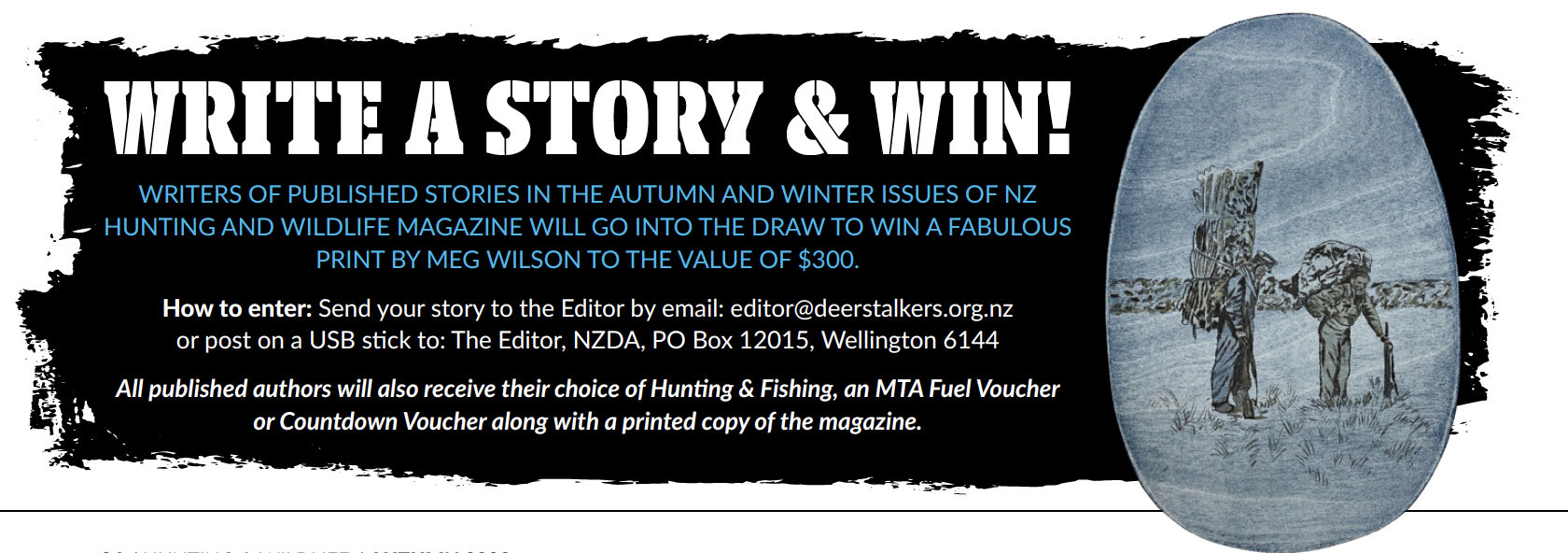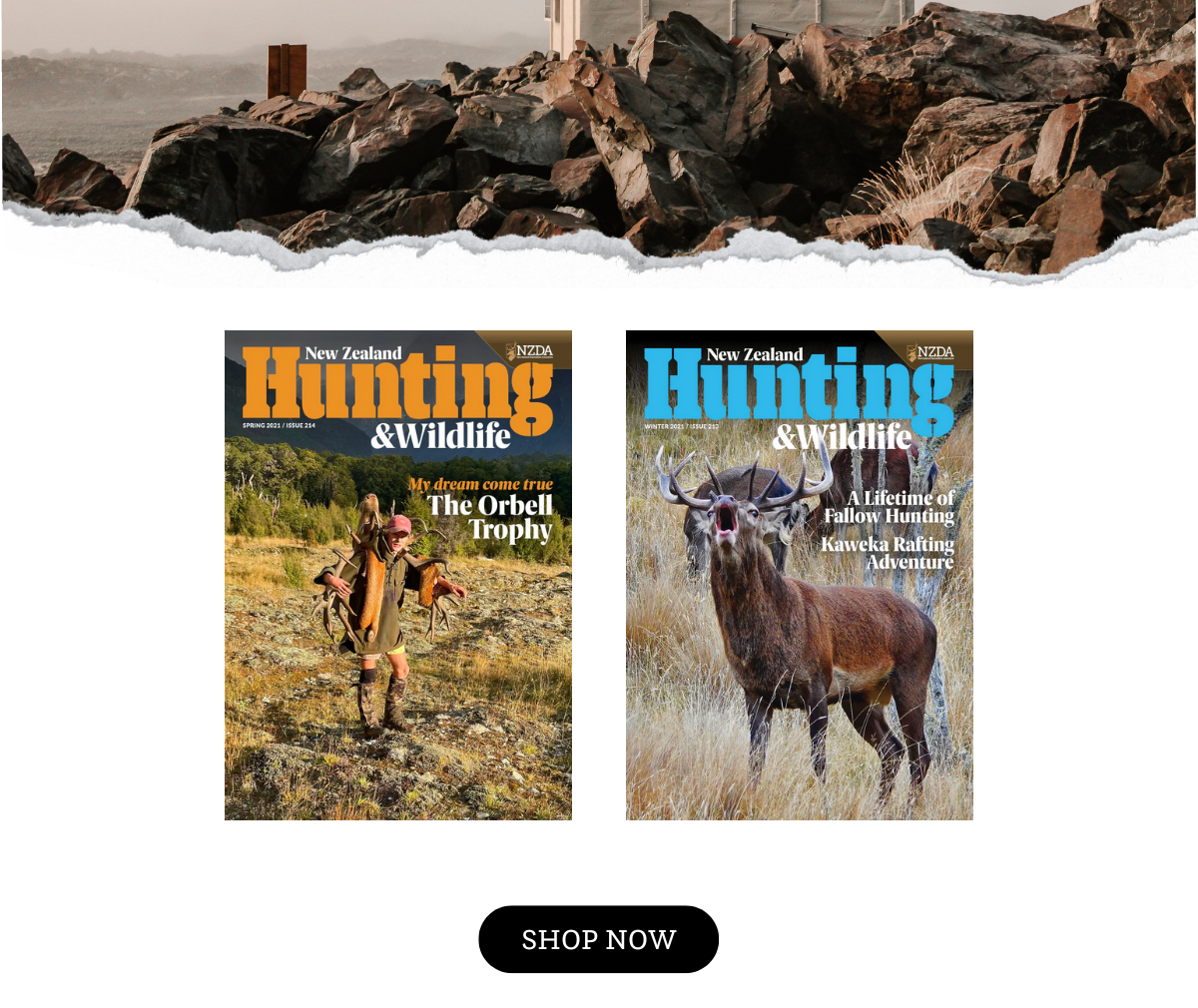TRACKING WOUNDED DEER
19 March 2023
Hunting and Wildlife Magazine - Issue 220 Autumn
Words By: Simon Gibson
The Ruahine Range in the North Island is a great area to hunt with a good track and hut network giving shelter when the weather turns nasty. I was hunting the Pohangina Valley with a couple of mates where we had based ourselves at the Mid-Pohangina Hut for a week. The hunting was good and I had several stags on the deck after a few days so was taking it easy at the hut for a well-earned morning off. As lay in the sun I noticed Paul working his way down the river and back to the hut. I keenly awaited his report on the mornings hunting but it was a tale of woe. He had seen a stag feeding on a slip up off the river and was sure his shot had connected but found no sign of the animal so carried on assuming he had missed.
Questioning him about how the animal had reacted on the shot I was 100 percent certain his shot had connected but was a gut shot. On the shot the animal reacted instantly by kicking out its back legs and then crashing off directly downhill, classic signs of a gut shot. Another indicator that it was a gut shot was that there was no blood found.
I insisted we go back and have a good look around. On the slip where the stag had been standing there was no sign of any blood, clumps of hair or stomach contents indicating a hit, but at the bottom of it I found some fresh scuff marks and patches of short hair. I was certain the stag had lost its footing and skidded down on its front legs which definitely meant it had been hit. A terrace ran along the side of the river and the hill beside it was very steep. A wounded deer will normally take the path of least resistance so I was certain it would have travelled up river on the terrace (Paul would have seen it if it had come down river) and lain down when it felt safe and probably not too far away as Paul had not gone in that direction chasing it. I set off methodically zig-zagging through the river terrace and sure enough after 15 minutes of searching I found the stag in a little clear area where he had obviously spent some time before dying going by the scuff marks in the forest floor.
Wounding a deer is a reality of hunting and always very disappointing. The longer you hunt, the more chance there is of wounding a deer and sometimes being unable to find it, no matter how good a hunter or shot you are. There are many factors that can cause bad shot placement: the animal moves as you fire, your shot is hasty, the trigger is yanked resulting in the firearm being pulled slightly sideways which often results in a gut shot, your rifle is not properly sighted-in (no excuses for this one), you haven’t calculated bullet drop or wind drift correctly when long range shooting, the bullet deflects off an unseen branch – to name just a few.
Hunters are sometimes too lazy to search for an animal because they think they’ve missed it, but this is often not the case. Many times the wounded animal can be tracked by following blood trails, hoof marks, likely direction of travel, broken foliage and sound as the animal moves off.
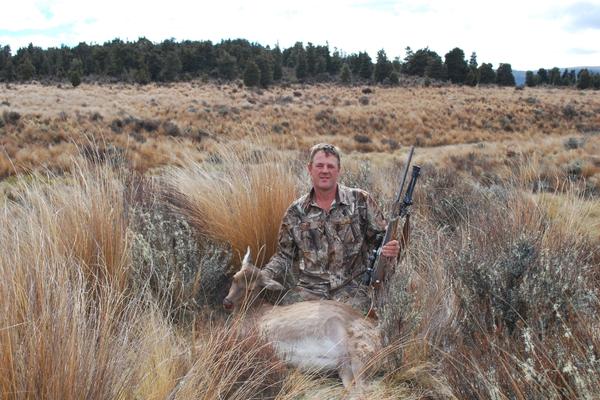
It can be surprising how hard it is to find a deer is this type of country, especially if shot from a distance.
Where was it hit?
If you miss an animal altogether, it will usually stand looking towards the direction of the shot for a brief period before moving off, especially if you are using a suppressor – or it may even just stay there, allowing a second shot. But an animal that has been hit, no matter whereabouts on the body, will react instantly from the shock of the impact and either drop on the spot or take off. This is where it is great to have a mate watching through their binoculars when you take the shot as you will often miss the animals reaction due to recoil.
It’s essential you hit an animal in the hilar or Kill Zone, where the vital organs and major blood vessels are located, in order to drop it quickly. This area in the chest is where the lungs, heart, and major blood vessels are, and about the size of a dinner plate on a mature red deer. While varying in size for different species, the hilar area is the same on all game animals and understanding its importance when placing a shot is one of the fundamentals of being a good hunter. When a deer is standing side on, aim one third of the body depth up from the bottom of the chest and directly in line with the foreleg. A shot through the shoulder here will hit the centre of the hilar zone. The bullet will break the shoulder and then hit the lungs and major arteries behind, causing a lot of damage and hydraulic shock to the vital organs, before perhaps exiting the far shoulder. Any deer hit here will not go far. A bullet striking this area usually makes a loud “whack” noise and the animal will usually jump and run forward instantly.
An animal shot through the guts will jump, possibly kicking out with its back legs, and then run off, hunched up; there will be little in the way of a “whack” noise indicated a hit. A gut-shot animal can be very hard to track as there will not be much in the way of blood if any.
A shot in line with the hilar zone but which has gone too high will hit the top of the lungs and there won’t be a lot of bleeding, but the animal will usually drop within 100 metres. If the shot has gone higher it will have hit the spine and the animal will drop instantly. If it’s only close to the spine, it will cause spinal concussion and again the animal will drop instantly – but be aware: the animal may only be temporarily down. This is also one of the drawbacks with neck shots, and why I avoid them. A spine-shot animal will often need a finishing shot. If the shot has gone too low and strikes the leg, the animal will move off in an uneven run and an animal with that sort of wound can be extremely difficult to find as they can go considerable distances.
When you get up to a fallen deer, touch its eyeball with the tip of your barrel: if it blinks, it’s still alive. In these circumstances I immediately put a round into the animal’s head, or behind its shoulder if it’s a trophy stag. Many hunters will use a knife to cut the animal’s throat – however you then run the risk of the deer getting to its feet when grabbed, and running off. I’ve witnessed this several times with big stags, and they were never seen again.
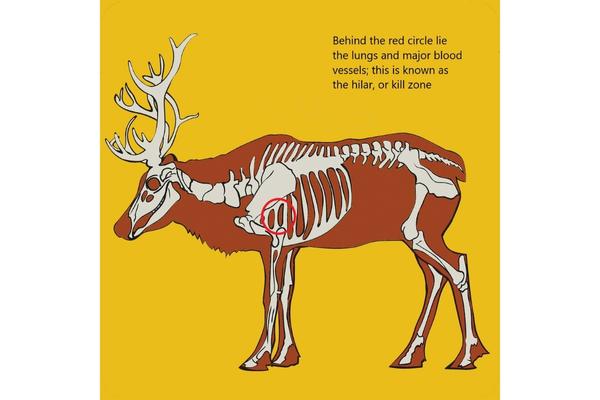
Tracking wounded deer
After the shot, if the animal hasn’t dropped but has run off, stay still and listen to the sound of the departing deer to get an idea of direction. A deer that has not been hit will often make little noise moving through the bush, but a badly-hit animal will usually crash through it; but, that said, this is not always the case. ALWAYS load another round and, while keeping the rifle in a safe state, be ready to fire again, especially as you move towards a downed animal. You may only have seconds to take another shot when sighting the animal again. If you’ve fired a number of shots, reload your magazine before moving off.
If you are going to leave your pack or day bag behind while you search, whatever you do, make sure it is obvious so you can find it again. Leave it on a log, hang a bright piece of clothing above it, GPS mark it. If you are leaving your gear, make sure you take spare ammo, a knife and a torch with you. These simple steps may save you a night out with no gear.
A wounded deer will take the path of least resistance, meaning it will travel around the side of a hill, or will go downhill – and often not far, unless it knows it’s being followed. Rarely will a badly-wounded animal go uphill. Unless they know they’re being followed, they’ll usually not go far before finding a place of concealment and lying down. After 10 - 15 minutes the wounds will make the animal stiffen up and it will be much slower getting up and running off if spooked by a tracking hunter, so it’s best to wait a while instead of immediately rushing after a wounded deer. If you suspect a gut shot, then waiting half an hour or longer is a good idea. When a wounded animal is found, you usually have only a few seconds to take a shot, so be ready for it and don’t muck around, and as I mentioned before, trying to use a knife is utter nonsense.
Weather and the time of day will probably dictate your immediate course of action. If it’s early morning on a fine day you can really take your time – but if it’s getting dark, or heavy rain is washing sign away, you may need to act more quickly.
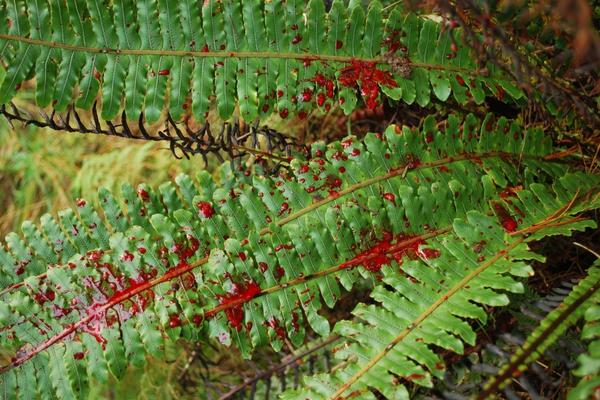
Bright frothy blood is a sign of a lung shot. In this photo, the blood has been coming out of the deers mouth and sprayed over vegetation. With this amount of blood being lost, the animal will be close by.
What to look for
When I’m bush hunting, and the animal has departed without dropping, I always mark the spot I fired from with a piece of toilet paper hanging off a tree branch at head height, and I then move over to where the animal was standing and mark that also. If I know the direction of departure, that too will be marked. If you were shooting across onto a face, it’s very important to be absolutely clear where the deer was standing before you move. Use a dead tree, log or rocky outcrop to give you a reference point once you get onto the face, otherwise it can be very difficult to find the animal’s location when you get there. If you have a range finder, and you haven’t done so already, range the distance to where the deer was standing. Once you get over to where you think it was, you can range back to where you shot from and this will tell you if you’re close to where you should be.
Once I reach where the animal was, I look very closely at the immediate area. I’m looking for any blood, tufts of hair that have been cut off the deer as the bullet struck, bone fragments (which normally indicate a leg wound), hoof prints where dirt has been flung up in front of the print, or drag marks as the animal makes a hasty departure, and broken foliage where the animal has crashed through. It’s quite common for there to be no sign of blood at all until you get 20 or so metres from where the deer was standing, as the wound begins to bleed out.
Now, very methodically follow the route the deer took when it crashed off, marking it as you go with pieces of toilet paper. You’re looking for blood or animal tissue (such as lung parts) on the ground, blood smeared on the bush if the animal has pushed through, hoof prints that are splayed out, and vegetation that’s bent or freshly broken. On finding each piece of sign, mark it with a piece of toilet paper on a branch above it. When you lose the trail you can then return to the last piece of sign found, and start again. Be careful to look into windfalls, under fallen trees, in thick patches of bush, overhanging banks beside creek beds, and patches of high fern, as wounded deer will seek a concealed hiding place. Look too for the distinct light-coloured underside of damaged fern fronds bent over by the fleeing animal.
Blood can tell you a lot about where the animal’s been hit. Bright, frothy blood is a sign of a lung shot and is often sprayed over the ground and bush as it comes out of the animal’s mouth. A deer with these symptoms won’t go far. Medium red-coloured blood usually signifies a leg or neck wound, and it may be sprayed in lines. An animal hit here can travel a considerable distance – especially if a following hunter spooks it from where it has lain down. Watery green/yellow droplets that smell strongly of deer indicate a gut shot and you should give the animal plenty of time to lie down and stiffen up. A gut-shot animal will leave little sign ... however they will usually not go far unless spooked. If you lose a trail, start circling around the last piece of sign you found, looking for the next clue. Blowflies are experts at finding blood or particularly gut contents, so keep an eye and ear out for activity from them.
Deer can often have quite a strong smell too, so this is another clue to follow, especially when there is little wind; their scent can remain around for a while.
As you follow their trail you may find a pool of blood where the animal has stood. If you find an area of scuffed-up ground with blood and hair present the animal has been lying down, and there’s a good chance you’ve just spooked it. In this instance, wait and give it some time to stop and lie down again. When a blood trail slowly diminishes over a distance, the wound is clotting and may indicate the animal was not badly hit.
The best assistance you can give yourself in preparing for this scenario is in your bullet selection; modern premium controlled-expansion bullets of at least a medium weight for your calibre are well worth the extra expense as they hold together after an initial rapid expansion, thus giving good penetration to exit even on large animals, creating a large exit hole. For the biggest game such as sambar, wapiti, or bull tahr it’s really good insurance to select a heavy projectile for your hunt.
As I’ve said, badly-wounded animals will almost invariably take the path of least resistance: sidling around the hillside, using game trails, or heading directly downhill. It’s very unlikely they’ll go uphill, or push through thick scrub. If you completely lose a trail, then head in the general direction of travel the trail was taking you, and if possible zig zag across the face to maximise your chances of finding the next piece of sign.
Tracking a wounded animal can be a time-consuming process, but as a hunter it’s your duty to do everything possible to find the creature and put it out of its suffering. By methodically searching the area looking for tell-tale signs of where the animal has travelled: blood trails and the type of blood, deer hair, broken foliage, hoof marks, reading the terrain etc, you can put the odds of finding the animal firmly in your favour. If not, at least you’ll know you’ve tried your hardest to get a good outcome.
Write for Hunting and Wildlife
